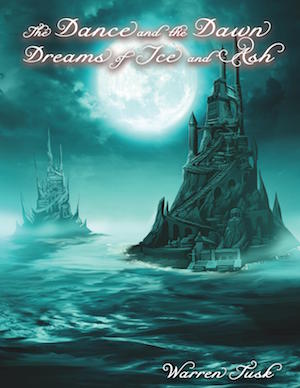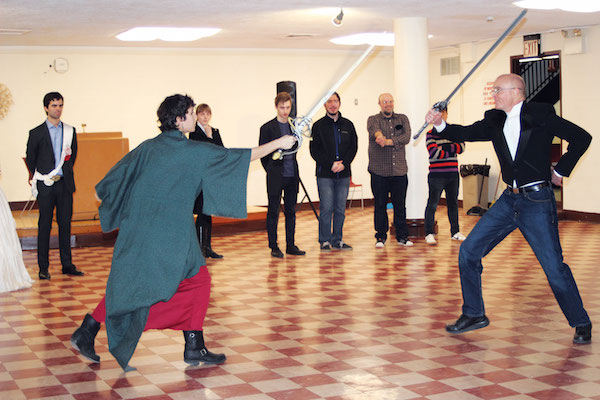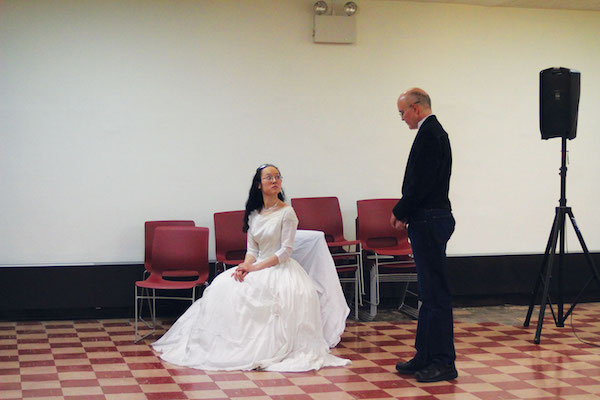BY CHARLES BATTERSBY | A generation ago, “Dungeons & Dragons” redefined the word “game” to many people. In D&D, players created roles for themselves, and Dungeon Masters told stories that starred those characters. However, this sort of “roleplaying game” doesn’t have to be about killing monsters, or played sitting around a table.

Some people take their games away from the table and do live-action roleplaying, or LARP. Paracelsus Games creates and publishes a form of LARP called “Theatrical Experiences,” which have elements in common with games and improvisational theater. They recently presented one such LARP called “The Dance and the Dawn,” in conjunction with the New York Public Library (NYPL).
The term LARP is often associated with people running around in parks, with foam swords (this is what players call “boffer” LARP). “The Dance and the Dawn” does have some swordplay, but the focus is on character interaction between its 15 players. These players take on the roles of noble Ladies and Lords at a midnight ball, where everyone is seeking out their true love. Each player is assigned a role in advance by the person hosting the game. In this case, the event is hosted by representatives from the NYPL and Paracelsus Games, but anyone can buy a copy of the game and host their own performance.
Warren Tusk, the Creative Director at Paracelsus Games, is the author of “The Dance and the Dawn” — which he describes as being “different from boffer LARPs, in that it focuses on heavy roleplay with no physical-sport combat element, and different from ‘Nordic’ LARPs, in that it works largely with elaborate pre-created plot and characters.”
Every character in “Dance” has a true love at the ball, but they don’t know who that is until the end of the game. Players only know the details about their own character, and have to mingle to learn about the others. All of the dialogue and interaction is improvised. Character have unique personality traits, and abilities like magical spells and/or sword fighting skills. These can be used to vie with one another for the favor of a particular dance partner, or to learn clues about the backstory of the game’s setting and characters.
“Dance” uses a format similar to speed dating, where Ladies can choose a Lord to dance with, and converse while waltzing. The dancing is real, and each performance of “The Dance and the Dawn” involves a brief lesson on how to waltz. The event lasts four hours, with players dancing, then taking breaks to mingle and converse. Tusk says this format “shepherds the players through each moment of their experience, rather than leaving them to putter around unguided and find their own interactions.”
Tusk designed the game so that characters have ideal “pairings” in which every Lady has a specific Lord who is ideally suited to her. Ending up in the right pair might seem like a way to win the game, but Tusk doesn’t see it that way. According to him, “The player’s goal should be to experience the most compelling story, and that can certainly happen whether or not the character finds true love. I’ve had PCs [player characters] undergo devastating romantic tragedies and walk out feeling like it was a really cool thing to witness from the inside. For that matter, I’ve had players deliberately forgo true love because they were so attached to the ‘wrong’ PC romances that they developed over the course of the game. It would be incredibly foolish to say that those people ‘lost.’ ”

“Dance” has been produced in a variety of locations, including college classrooms, Off-Off Broadway theaters, and a games cafe in Beijing, with the most recent NYC production having taken place on Jan. 30 at the Hudson Park Library. This unusual venue, Tusk says, “provides useful gaming spaces, and helps us reach out to potential players that we wouldn’t have a way to reach on our own.”
Miranda Murray, the Library Manager at Hudson Park, notes that staging a LARP was a new experience for her. “I’m always looking for new and exciting programs and new things to attract people to our library,” she says. “We’re in the West Village, and we certainly have lots of cultural institutions in the neighborhood that are exciting for our patrons, and I was looking for something to compete with that, and have something new.”
Just about any LARP will involve NPCs or “non-player characters.” They portray characters, just like players do, but the NPCs are part of the staff hosting the show. In “Dance,” the NPCs are the Queen of Ice, and the Duke of Ash. Players compete to earn the favor of the Queen and Duke, and can even unravel a mystery about their backstory, which might affect how the game plays out.

At the Hudson Park Library show, we spoke with the people who played the NPCs, David Kotsonis (the Duke of Ash) and Aili Klein (the Queen of Ice). Both of them first experienced the show as players in past productions, but volunteered to play NPC roles. “I watched the Duke and the Queen have their very dramatic moment, I was like ‘Wow! I want to do that!’ ” said Klein of her earlier experience as a player.
Kotsonis explained that players are allowed to read the game documents about other characters after the game, and he was “struck by the Duke and Queen’s backstory, and the Duke’s side of it,” so he asked to play the role himself in the recent production.
Interested players who missed the Jan. 30 production can participate in the sequel to “The Dance and the Dawn,” called “Dreams of Ice and Ash.” The action unfolds at Jefferson Market Library (corner of Sixth Ave. & W. 10th St.) on Fri., Mar. 4, from 6–10 p.m. The event is free, but interested players must register before Fri., Feb. 26. To do so, visit paracelsus-games.com.

















